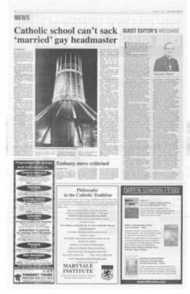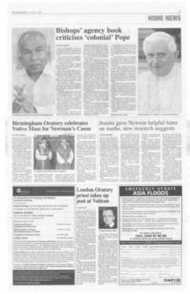Page 9, 17th August 2007
Page 9

Report an error
Noticed an error on this page?If you've noticed an error in this article please click here to report it.
Tags
Share
Related articles
Newman Would Want Us To Honour Our Lady For His Miracle
Now It's Time To Make Advent Really Mean Something Again
Prayer Initiative On Patrick's Day
Feast Held To Revive Devotion
The Loveliest Of Feasts
United by the prayer of Mary
Bishop Malcolm McMahon says that feasts like the Assumption can unite rather than divide Christians
Every year on August 15 Catholics throughout the world celebrate with great joy the feast of the Assumption of Mary. It is considered to be a distinctly Catholic feast so it will come as a surprise to many Catholics that in most Anglican prayer books this day is celebrated as a principal feast in honour of the Blessed Virgin Mary with its own Scripture readings, collect and proper preface.
Undoubtedly there has been a resurgence of interest in the place of Mary in Anglican worship in the last century. In the years following the Reformation the calendar of the Church of England had five feasts associated with Mary: the Conception of Mary, Nativity of Mary, Annunciation, Visitation and the Purification or Presentation. There was, however, no longer a feast of the Assumption. This was not only because the Assumption was understood to lack scriptural warrant but it was also seen as exalting Mary at the expense of Christ.
Whenever Mary is mentioned in the Anglican liturgy prominence is given to her role as "pure virgin" from whose "substance" the Son took human nature. Undoubtedly reverence for Mary continued in the Church of England throughout the centuries to the present day. albeit in a diminished form.
In 2004 the AnglicanRoman Catholic International Commission (ARCIC) published the report: Mary: Grace and Hope in Christ. It had become apparent over the many years of theological discussion between our communions that the dogmas of the Immaculate Conception of Mary and the Assumption of Mary were still proving to be stumbling blocks on the path towards unity. But it was also recognised that two other important areas of teaching concerning Mary have been accepted by both Anglicans and Catholics for centuries. The first of these, and the most fundamental, is the doctrine that Mary is the Mother of God, or Theotokos, which was defined at the Council of Ephesus in AD 431. The other one is the Virginity of Mary. This doctrine was determined by the Council of Chalcedon in AD 451 when it accepted the letter from Pope Leo the Great which clarified the doctrine on the two natures in Christ, human and divine. In that letter, which became known as the Tome of Leo, Mary is described as "virgin".
A third area of doctrine, which is universally accepted by Catholics but with which some Anglicans have difficulty, is the Catholic belief that saints have an intercessory function. In other words, we pray to our saints, and especially Mary, to intercede with Christ for us. Some Anglicans consider that this is unnecessary and that it is sufficient to pray directly to God. But the experience of Catholics is that their prayers are more readily heard if they have the support of a saint. This raises another matter about the function of the communion of saints which would be part of a larger question concerning the nature of the church. Perhaps this could form the agenda for future ARCIC meetings?
But let me get back to Mary. The work of ARCIC began with reading afresh the Scripture passages relating to her. The members of the commission agreed a common interpretation, and you will find this section of the report is a very rewarding reflection which many will find helpful with their personal prayer. In the same way as the Scriptures were read anew, so too were the Fathers of the Church. These writings form part of the ancient common tradition of the Church and hold a special place in our common Christian heritage. It is in the tradition of the Church rather than the Scriptures that we find the doctrines of Mary's sinlessness and the Assumption. For Catholics these two doctrines are matters of faith. In other words they form part of the deposit of faith which has been handed down to us through the centuries, and as such they form an essential part of the faith of the Roman Catholic Church.
The dogma of the Immaculate Conception of Mary, which was defined by Pope Blessed Pius IX in 1854, states that Mary was conceived without sin and remained sinless throughout her life. The Assumption states that Mary was assumed body and soul into heaven, and Pope Pius XII defined this dogma in 1950. These dogmas are seen as problematic by Anglicans as they have no direct scriptural basis. However, one of the conclusions arrived at by the ARCIC was that these two papal definitions understood within the bibli cal pattern of the economy of hope and grace, can be said to be consonant with the teaching of the Scriptures and the ancient common tradition. This understanding was arrived at by a common reflection of the commission on St Paul's Letter to the Romans (8:30). The question was posed: How would St Paul talk about the Immaculate Conception and the Assumption? In other words, what language would he use to describe these two truths? The key to a deeper understanding, if not a definitive solution, of this problem is to reflect on St Paul's words: "Those whom God predestined he also called; and those whom he called he also justified; and those whom he justified he also glorified."
We can then see that the Marian doctrines in the light of those four words of St Paul: predestined, called, justified and glorified, can be placed in the pattern of grace and hope we find in Holy Scripture. The ARCIC report is awaiting official comment from the Anglican Communion and the Congregation for the Doctrine of the Faith. But as we reflect on the Assumption of Mary we should remember one of the assertions of ARCIC, that Mary has a continuing ministry which serves the ministry of Christ. It is through Mary's prayers that our desire for Christian unity may be realised.
The closing words of the ARCIC report carry this sentiment: "Our hope is that, as we share in the one Spirit by which Mary was prepared and sanctified for her unique vocation, we may together participate with her and all the saints in the unending praise of God."
The Rt Rev Malcolm McMahon is Bishop of Nottingham. He helped to produce the report Mary: Grace and Hope in Christ (Continuum, £10.99)
blog comments powered by Disqus

















